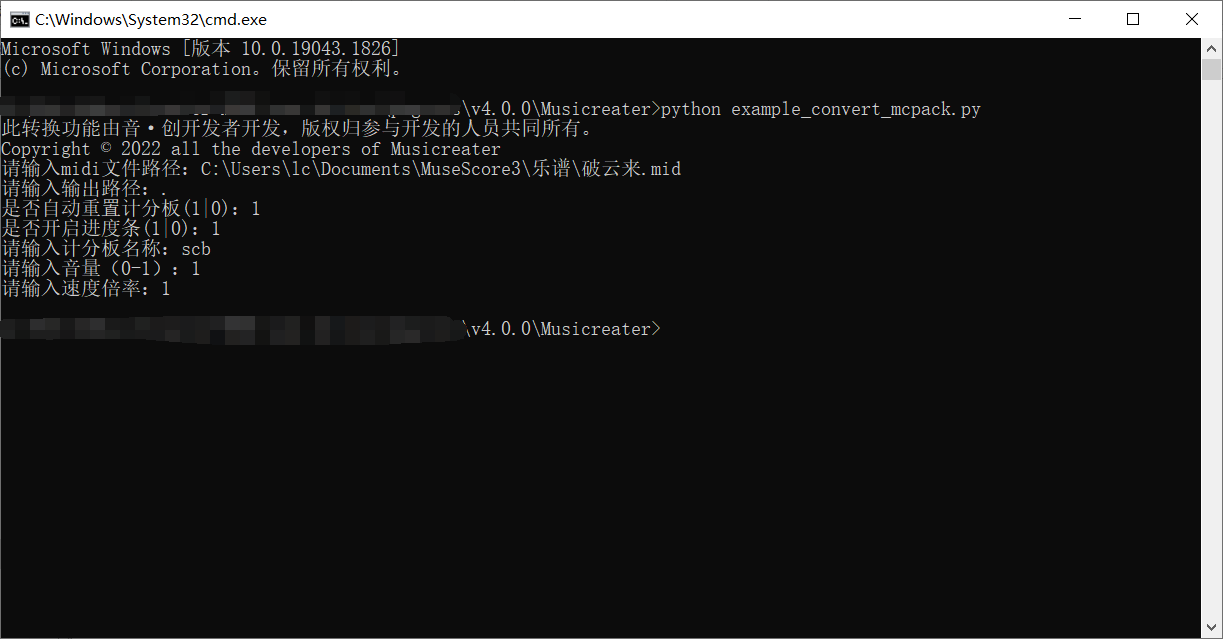4.1 KiB
Linglun Converter
Instructions for Using Demo(s)
This is a tutorial for using the demo(s) of this library, not the Development Guide.
Developing Documentation is now not translated yet, you can see here for the Chinese Orignal Version if you understand Chinese
Instructions of Downloading and Starting using Demo
Windows OS
Linux OS
Android OS
-
More Info for Parameters of Our Demo Program(s)

Input Prompt English Translation Description <AF><B7>输入MIDI文件路径| idi File Path| ath of a .mid file or a directory. While directory entered, our demo will convert all midi(s) in the directory| <AF><B7>输入输出路径| utput Path| here files converted in| <98><AF>否重置计分板| hether Reset Scoreboard Automatically| an only be 1 or 0(Recommanded 1)| 进度条[注]| rogressbar| hether to enable Progressbar and customize progressbar style. Type 0 or False to disable, 1 or True to use default style, or type using format taught in follow the Instructions below to customize one you like| <AF><B7>输入计分板名称| coreboard Name| Only not byDelay* The name of scoreboard that player using| <AF><B7>输入音量| olume| nly decimal in [0,1],(Recommanded 1)| <AF><B7>输入速度倍率| peed Multiplying Factor| aybe you want to play it faster(>1) or slower(>0 <1)?| <AF><B7>输入玩家选择器| layer Selector| ull Selector including @x. E.g: Play for players taggedHolo, enter@a[tag=Holo]on this parameter|
Instructions for Customize Progress Bar
We have supported the function of making progress bar in Minecraft's music player. And also the method of customize them. So the following instructions are about the parameters of the Progress Bar Customizition.
A Progress Bar, of course, is composed of changeless parts and changable parts. And the changable parts include texts or images(these images are made up of texts, or we can say, character paintings 😁). That is, for Minecraft, a changable image in a progress bar is just the "bar" part(which is like a stripe).
We use a string to describe the style of progress bar you need, and it includes many identifiers to replace the changable parts.
There are the identifiers:
| Identifier | Changable Part |
|---|---|
%%N |
Music name(file name which is imported into program) |
%%s |
Value of scoreboard of now |
%^s |
Max value of scoreboard |
%%t |
Current playback time |
%^t |
Total music time |
%%% |
Current playback progress |
_ |
To be replaced by the Bar part of the progress bar |
The _ is a placeholder to identifying the bar part, yeah, just the changable image.
This is an example of style description string, and this is also the default style of Musicreater's progress bar.
▶ %%N [ %%s/%^s %%% __________ %%t|%^t]
This is a progress bar with only one line, but it is possible if you want to give a multiline parameter into the style description string.
But the string above is only for style identification, but we also need to identifying the changable image's image(just what the bar's look).
A "bar", simply, included 2 parts: Have Been Played & Not Been Played. So we use a tuple to pass the parameter. It's under a simple format: (str: played, str: not). For example, the default parameter is below:
('§e=§r', '§7=§r')
So it's time to combine what I said in one parameter now!
This is a default definder parameter:
('▶ %%N [ %%s/%^s %%% __________ %%t|%^t]',('§e=§r', '§7=§r'))
Tip: To avoid errors, please not to use the identifiers as the other part of your style.